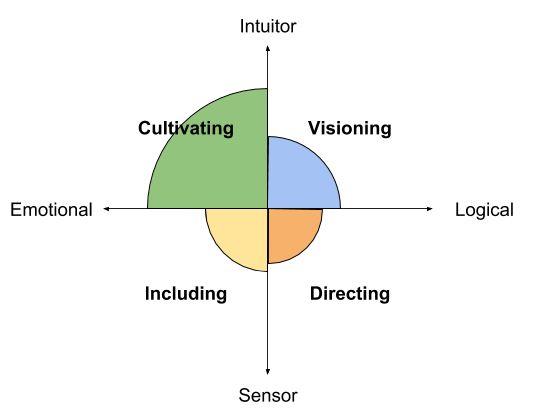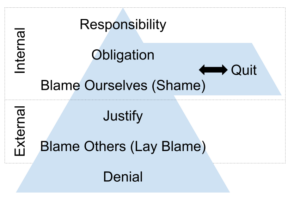 Dare to Lead: Brave Work. Tough Conversations. Whole Hearts by Brene Brown
Dare to Lead: Brave Work. Tough Conversations. Whole Hearts by Brene Brown
My rating: 5 of 5 stars
What, if anything, about the way people are leading today needs to change in order for leaders to be successful in a complex, rapidly changing environment where we’re faced with seemingly intractable challenges and an insatiable demand for innovation? We need brave leaders and courageous culture
There are ten behaviours and cultural issues which get in the way of organisations:
- We avoid tough conversations, including giving honest, productive feedback.
- We manage problematic behaviour rather than acknowledging and addressing fear and feelings during change.
- Diminish trust caused by a lack of connection and empathy.
- Not enough people are taking smart risks or creating and sharing bold ideas to meet challenging demands and the insatiable need for innovation.
- We get stuck and defined by setbacks, disappointments and failures so we waste time and energy reassuring people who question their value and contribution.
- Too much shame and blame, not enough accountability and learning.
- Opting out of vital conversations about diversity and inclusion because they fear looking, saying or being wrong.
- When things go wrong we rush into ineffective or unsustainable solutions rather than staying with problem identification and solving.
- Values are vage instead of actual behaviours which are taught, measured and evaluated.
- Perfectionism and fear are keeping people from learning and growing.
The Rumble is a discussion, conversation or meeting defined by a commitment to lean into vulnerability, to stay curious and generous, to stick with the messy middle of problem identification and solving to take breaks and circle back when necessary, to be fearless in owning our parts, and to listen with the same passion we want to be heard.
The 6 myths of vulnerability –
Vulnerability is weakness – there can be no act of courage without vulnerability,
I don’t do vulnerability – life is fundamentally uncertain with risks and emotional exposure,
I can go it alone – humans are hardwired for connection as a social species,
Engineer the uncertainty and discomfort out of vulnerability – this is not something which you can fix out there it’s something you have to develop inside yourself,
Trust comes before vulnerability – in reality one can’t grow without the other,
Vulnerability is disclosure – this is not about oversharing its about leaning into conversations.
Ask your team”What does support from me look like?”
| Armored Leadership | Daring Leadership |
| Driving perfectionism and fostering fear of failure | Modeling and encouraging healthy striving, empathy and self-compassion |
| Working from scarcity and squandering opportunities for joy and recognition | Practicing gratitude and celebrating milestones and victories |
| Numbing | Setting boundaries and finding real comfort |
| Propagating the false dichotomy of victim or viking, crush or be crushed | Practicing integration – strong back, soft front, wild heart |
| Being a knower and being right | Being a learner and getting it right |
| Hiding behind cynicism | Modeling clarity, kindness and hope |
| Using criticism as self-protection | Making contributions and taking risks |
| Using power over | Using power with, power to, and power within |
| Hustling for our worth | Knowing our value |
| Leading for compliance and control | Cultivating commitment and shared purpose |
| Weaponising fear and uncertainty | Acknowledging, naming and normalising collective fear and uncertainty |
| Rewarding exhaustion as a status symbol and attaching productivity to self-worth | Modeling and supporting rest, play and recovery |
| Tolerating discrimination, echo chambers and a “fitting in” culture | Cultivating a culture of belonging, inclusivity and diverse perspectives |
| Collecting gold stars | Giving fold stars |
| Zigzagging and avoiding | Straight talking and taking action |
| Leading from hurt | Leading from heart |
Shame 1-2-3s:
- We all have it. Shame is universal and one of the most primitive human emotions that we experience.
- We’re all afraid to talk about shame. Just the word is uncomfortable.
- The less we talk about shame, the more control it has over our lives.
Guilt = I did something bad. Shame = I am bad.
If shame is obvious then you have a big problem but it can exist in organisations but in a much less obvious way such as: perfectionism, favoritism, gossiping, back-channeling, comparison, self-worth tied to productivity, harassment, discrimination, power over, bullying, blaming, teasing, cover-ups….
Empathy skills:
- To see the world as others see it, or perspective taking
- To be non-judgemental
- To understand another person’s feelings
- To communicate your understanding of that person’s feelings
- Mindfulness
 How NASA Builds Teams: Mission Critical Soft Skills for Scientists, Engineers, and Project Teams
How NASA Builds Teams: Mission Critical Soft Skills for Scientists, Engineers, and Project Teams
 Getting to Yes: Negotiating Agreement Without Giving In
Getting to Yes: Negotiating Agreement Without Giving In The First 90 Days: Critical Success Strategies for New Leaders at All Levels
The First 90 Days: Critical Success Strategies for New Leaders at All Levels
 Ego Free Leadership: Ending the Unconscious Habits that Hijack Your Business
Ego Free Leadership: Ending the Unconscious Habits that Hijack Your Business Difficult Conversations: How to Discuss What Matters Most
Difficult Conversations: How to Discuss What Matters Most
 Switch: How to Change Things When Change Is Hard
Switch: How to Change Things When Change Is Hard Decisive: How to Make Better Choices in Life and Work
Decisive: How to Make Better Choices in Life and Work Made to Stick: Why Some Ideas Survive and Others Die
Made to Stick: Why Some Ideas Survive and Others Die The Responsibility Process: Unlocking Your Natural Ability to Live and Lead with Power
The Responsibility Process: Unlocking Your Natural Ability to Live and Lead with Power